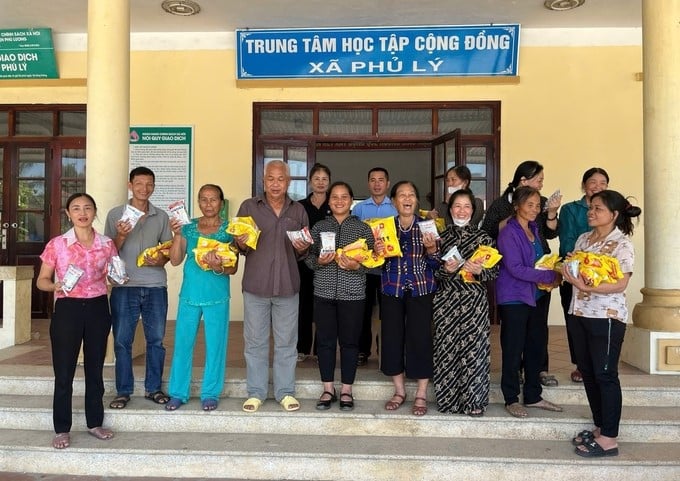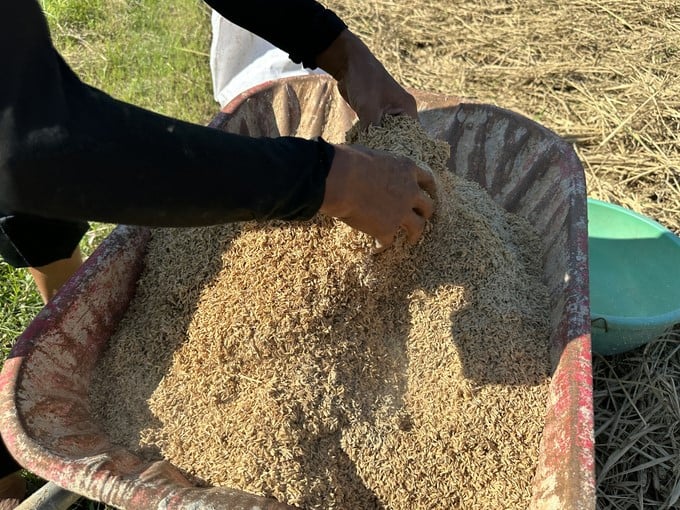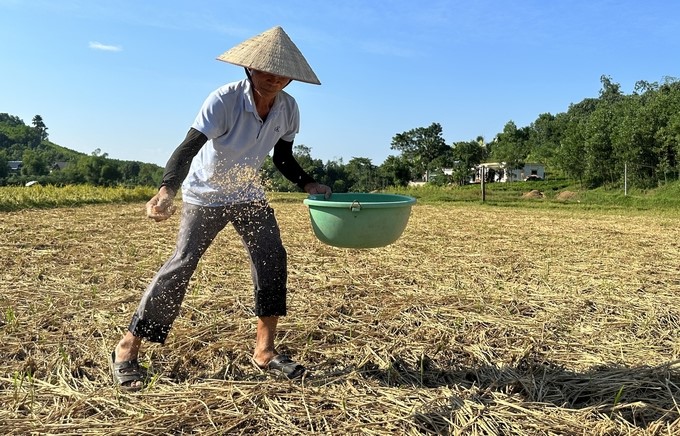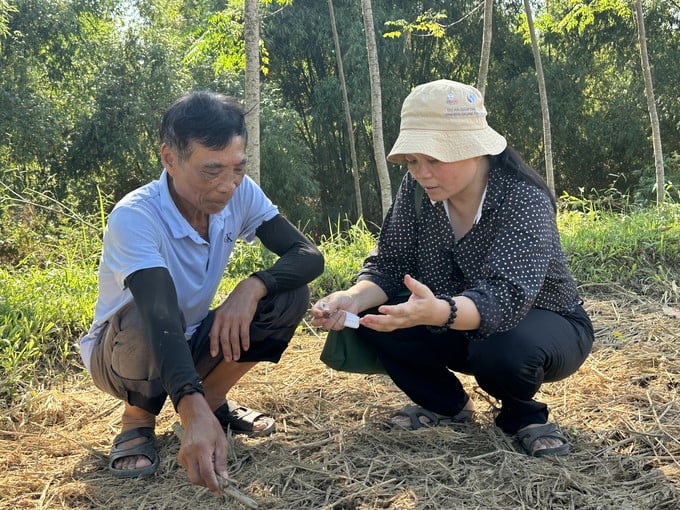June 2, 2025 | 12:51 GMT +7
June 2, 2025 | 12:51 GMT +7
Hotline: 0913.378.918
June 2, 2025 | 12:51 GMT +7
Hotline: 0913.378.918
After storms and floods, a large amount of plant residue appeared in the fields. This greatly hinders land preparation for winter crop production and even poses a potential risk of outbreaks of many pests and diseases.
In the above context, the Center for Organic Agriculture (Vietnam National University of Agriculture) has coordinated with the Vietnam Organic Agriculture Association (representative of the Green Vietnam Project) and the sponsor of SASAKI-ORGEN to deploy a support program for disadvantaged areas affected by Typhoon No. 3 to restore production in Phu Ly commune, Phu Luong district (Thai Nguyen).

Farmers in Phu Ly commune, Phu Luong district (Thai Nguyen) enthusiastically received Emuniv microbial preparation. Photo: Quang Linh.
The program is implemented from September 23 to October 5, supporting farmers with 361 kg of CP511 corn seed and 400 packages of Emuniv microbial preparation. In addition to supporting seeds and agricultural materials, the program also provides training on techniques for developing winter crops; applying microbial technology to treat plant residues in the field, reduce pests and diseases, and make organic fertilizer; and corn land preparation techniques that help minimize labor, are simple, easy to implement, and bring high productivity.
During the recent storms and floods, Phu Ly commune lost nearly VND 18 billion in many fields. Regarding agriculture, it was recorded that 104 hectares of rice and crops were flooded; most of the area could not be repaired. Many farmers in Phu Ly commune seemed to completely lose this year's rice crop, so they put all their hopes in the upcoming winter corn crop.
From early morning, many people came to the Community Learning Center at the Phu Ly Commune People's Committee to have experts share experiences on techniques for treating straw and fields after floods with microbial preparations.
Mr. Bui Quang Huu, residing in Dong Cho hamlet, Phu Ly commune, enthusiastically proposed that experts from the Center for Organic Agriculture provide guidance in his field.

Mixing microbial preparation. Photo: Quang Linh.
"In the commune, there are households that have used microbial preparations to treat straw. The effect is very good. They almost do not need to fertilize and use little pesticides. They work leisurely in the fields, but I keep busy. Today with experts from Hanoi is an opportunity for me to change my way of doing," said Mr. Huu.
Holding a package of Emuniv biological preparation, Ms. Bui Thi Hong Ha, Director of the Center for Organic Agriculture, instructed Mr. Huu and the farmers present on how to mix and treat straw with Emuniv biological preparation.
Specifically, farmers sprinkle microbial preparations evenly on the field surface with a dose of 1 package of Emuniv 200g mixed with 3–5 kg of powdered soil (sand or manure), moistened, and then sprinkled evenly on 500 m2 of field surface. After that, run the machine to bury the straw and proceed to take water for tillage as normal.
In addition, farmers can spray microbial preparations directly onto the field surface with a dosage of 1 package of Emuniv 200g mixed with clean water and sprayed evenly on 500 m2 of field surface. After that, run the machine to bury the straw and proceed to take water for tillage as normal.
The agricultural expert noted that the process of sprinkling microbial preparation should be done quickly and evenly to avoid waste. Farmers should spread or spray when it is shady, most effectively before rain.
Ms. Ha said that compared with the control, the farmland using the Emuniv preparation is soft, smooth, light brown in color, and did not stink. The remaining straw in the field is soft without black rot. Because the field is left entirely straw to cover and the straw is treated with microbial preparations, there is no need to use herbicides or cultivating. Farmers only need to manage tall grass plants that compete for nutrients and light with corn trees.

Mr. Bui Quang Huu sprinkles microbial preparation on the field after receiving instructions from experts. Photo: Quang Linh.
Ms. Bui Thi Hong Ha said: "Treating plant residues in the field with microbial technology is both safe and eco-friendly, limits pests and diseases, converts straw to make fertilizer, and creates the soil environment. The soil is loose, not too soft in the rainy season and not too hard in the dry season."
When using Emuniv biological preparation to treat straw in the field, microorganisms in the preparation will secrete enzymes that strongly decompose organic substances, especially indigestible organic substances, into organic mineral form. Thereby, helping plants easily absorb, stimulate growth, and increase resistance to pests and diseases.
Post-harvest straw will be decomposed into soluble organic minerals by microbial preparations right on the field surface, so plants are easy to absorb every day, preventing soil rot and treating alum well.
From there, along with the superior soil microflora, the preparation helps the soil recover after each farming cycle without the need to use chemical fertilizers. Using microbial preparations to treat straw not only helps farmers improve farmland but also motivates people towards green, sustainable, emission-reducing cultivation.
Regarding land preparation techniques for the winter corn crop, experts recommend that as soon as rice is harvested, all the straw is left in the field to cover the soil (which reduces water evaporation, keeps the field moist, and reduces weeds). Create furrows in the field by applying mechanization to reduce labor costs.
Depending on specific conditions, if the field is easy to drain, create 1 furrow for every 5–6 rows. For fields with difficult drainage, create 1 drainage furrow for every 3–4 rows and make furrows around the field. The depth of the furrow is 18-20 cm, and the surface of the furrow is 15-20 cm.

Ms. Bui Thi Hong Ha (right) instructs people how to care for plants after using microbial preparations. Photo: Quang Linh.
After hearing with their own ears and seeing with their own eyes how to treat straw with microbial preparations, many farmers in Phu Ly commune could not help but regret because they only now knew about this method.
Mr. Bui Phuong Thao, Chairman of Phu Ly commune, highly appreciated the participation of experts from the Center for Organic Agriculture and sponsors in the context of local people suffering heavy damage caused by floods.
Mr. Thao wishes: "Supporting and guiding farmers to use microbial preparations and improved rice production processes needs to be implemented widely and in the long term. Thereby, changing people's awareness about emission-reducing farming, helping to increase productivity and reduce the use of pesticides."
According to Ms. Do Phuong Chi, former Director of the Center for Environmental Analysis and Technology Transfer (Institute for Agricultural Environment), straw soaked in flood water for a long time will pose a potential risk of disease when farmers sow new crops if the soil is not well treated. Using microbial preparations to treat straw in the field, in addition to treating organic substances, also helps restore microorganisms in the soil.
Translated by Thu Huyen

(VAN) Several scientists and farmers are experimenting with soil treatment in some key durian-growing regions such as Cai Lay (Tien Giang), Dak Song, Gia Nghia, and Dak R’lap (Dak Nong).
/2025/05/25/4127-3-073637_820.jpg)
(VAN) Thanks to the promotion from an FAO-implemented project, vegetable production in greenhouses in Moc Chau has seen strong development, from 1.5 hectares in 2021 to nearly 50 hectares in 2024.

(VAN) FAO has recently supported USD 140,000 to implement the project 'Risk mitigation human-animal interface risks through disease control initiatives in pig farming.'

(VAN) The People's Committee of Tra Vinh province has approved an adjustment to the investment policy for the Green Hydrogen Plant project, increasing its area to approximately 52.76 hectares.
![Reducing emissions from rice fields: [2] Farmers’ commitment to the soil](https://t.ex-cdn.com/nongnghiepmoitruong.vn/608w/files/news/2025/05/05/dsc08881jpg-nongnghiep-140632.jpg)
(VAN) Clean rice cultivation model in Thuong Tan commune, Bac Tan Uyen district, is assisting local residents in achieving sustainable agriculture by substantially reducing costs, increasing productivity, and protecting the environment.

(VAN) At the conference to disseminate Resolution No. 68, AgriS introduced its digital agricultural ecosystem and reaffirmed its commitment to accompanying the Government in promoting private sector development and sustainable agriculture.

(VAN) 'Blue Ocean - Blue Foods' initiative is designed to restore marine ecosystems and establish sustainable livelihoods for local communities by cultivating a minimum of 1,000 hectares of cottonii seaweed in the first three years.